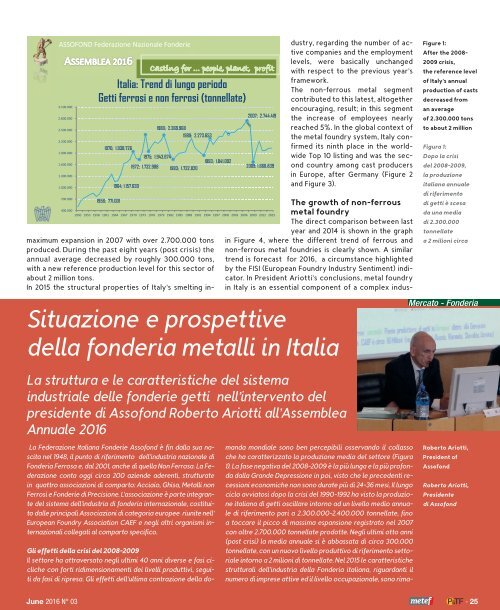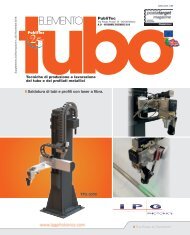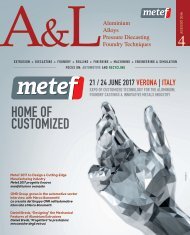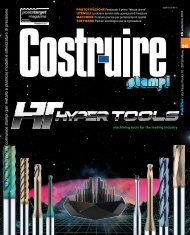Sfogliabile_AeL_n3_GIUGNO_2016
- No tags were found...
You also want an ePaper? Increase the reach of your titles
YUMPU automatically turns print PDFs into web optimized ePapers that Google loves.
maximum expansion in 2007 with over 2.700.000 tons<br />
produced. During the past eight years (post crisis) the<br />
annual average decreased by roughly 300.000 tons,<br />
with a new reference production level for this sector of<br />
about 2 million tons.<br />
In2015thestructuralpropertiesofItaly’ssmeltingindustry,<br />
regarding the number of active<br />
companies and the employment<br />
levels, were basically unchanged<br />
with respect to the previous year’s<br />
framework.<br />
The non-ferrous metal segment<br />
contributed to this latest, altogether<br />
encouraging, result; in this segment<br />
the increase of employees nearly<br />
reached 5%. In the global context of<br />
the metal foundry system, Italy confirmed<br />
its ninth place in the worldwide<br />
Top 10 listing and was the second<br />
country among cast producers<br />
in Europe, after Germany (Figure 2<br />
and Figure 3).<br />
The growth of non-ferrous<br />
metal foundry<br />
The direct comparison between last<br />
year and 2014 is shown in the graph<br />
in Figure 4, where the different trend of ferrous and<br />
non-ferrous metal foundries is clearly shown. A similar<br />
trendisforecast for<strong>2016</strong>, acircumstancehighlighted<br />
by the FISI (European Foundry Industry Sentiment) indicator.<br />
In President Ariotti’s conclusions, metal foundry<br />
in Italy is an essential component of a complex indus-<br />
Figure 1:<br />
After the 2008-<br />
2009 crisis,<br />
the reference level<br />
of Italy’s annual<br />
production of casts<br />
decreased from<br />
an average<br />
of 2.300.000 tons<br />
to about 2 million<br />
Figura 1:<br />
Dopolacrisi<br />
del 2008-2009,<br />
la produzione<br />
italiana annuale<br />
di riferimento<br />
di getti è scesa<br />
da unamedia<br />
di 2.300.000<br />
tonnellate<br />
a2milionicirca<br />
Situazione e prospettive<br />
della fonderia metalli in Italia<br />
Mercato - Fonderia<br />
La struttura e le caratteristiche del sistema<br />
industriale delle fonderie getti nell’intervento del<br />
presidente di Assofond Roberto Ariotti all’Assemblea<br />
Annuale <strong>2016</strong><br />
La Federazione Italiana Fonderie Assofond è fin dalla sua nascitanel1948,ilpuntodiriferimento<br />
dell’industrianazionaledi<br />
Fonderia Ferrosa e, dal 2001, anche di quella Non Ferrosa. La Federazione<br />
conta oggi circa 200 aziende aderenti, strutturate<br />
in quattro associazioni di comparto: Acciaio, Ghisa, Metalli non<br />
FerrosieFonderiediPrecisione.L’associazioneèparteintegrante<br />
del sistema dell’industria di fonderia internazionale, costituitodalleprincipaliAssociazionidicategoriaeuropee<br />
riunitenell’<br />
EuropeanFoundryAssociationCAEFeneglialtriorganismiinternazionali<br />
collegati al comparto specifico.<br />
Gli effetti della crisi del 2008-2009<br />
Ilsettorehaattraversatonegliultimi40annidiverseefasicicliche<br />
con forti ridimensionamenti dei livelli produttivi, seguitidafasidiripresa.Glieffettidell’ultimacontrazionedellado-<br />
manda mondiale sono ben percepibili osservando il collasso<br />
chehacaratterizzatolaproduzionemediadelsettore(Figura<br />
1). La fase negativa del 2008-2009 è la più lunga e la più profondadallaGrandeDepressioneinpoi,vistocheleprecedentirecessioni<br />
economiche non sono durate più di 24-36 mesi. Il lungo<br />
ciclo avviatosi dopo la crisi del 1990-1992 ha visto la produzione<br />
italiana di getti oscillare intorno ad un livello medio annuale<br />
di riferimento pari a 2.300.000-2.400.000 tonnellate, fino<br />
atoccareilpiccodimassimaespansioneregistratonel2007<br />
con oltre 2.700.000 tonnellate prodotte. Negli ultimi otto anni<br />
(post crisi) la media annuale si è abbassata di circa 300.000<br />
tonnellate, con un nuovo livello produttivo di riferimento settoriale<br />
intorno a 2 milioni di tonnellate. Nel 2015 le caratteristiche<br />
strutturali dell’industria della Fonderia italiana, riguardanti il<br />
numero di imprese attive ed il livello occupazionale, sono rima-<br />
Roberto Ariotti,<br />
President of<br />
Assofond<br />
Roberto Ariotti,<br />
Presidente<br />
di Assofond<br />
June <strong>2016</strong> N° 03 - 25





